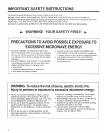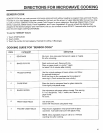
iNTRODUCTiON TO MICROWAVE COOKING
To get the best results from your microwave oven, read and follow the guidelines below.
Microwave cooking distributes heat differently from stove or oven cooking. In microwave cooking, food on the outside
of the dish absorbs more energy (and cooks more quickly) than food at the center. Arrange the food to allow for even
exposure to the microwave energy. Because foods are different, you need to arrange and cook them differently.
o STORAGE TEMPERATURE: Foods taken from the freezer or refrigerator take longer to cook than the same foods
at room temperature. The time for recipes in this book is based on the normal storage temperature of the food.
• SIZE: Small pieces of food cook faster than large ones; pieces similar in size and shape cook more evenly. For even
cooking, reduce the power when cooking large pieces of food.
® QUANTITY: Small amounts of food usually take less time than large amounts.
• SHAPE: Thin areas-and corners cook faster. Round shapes and rings cook more evenly because microwaves
penetrate foods to about 1 inch from the top, bottom, and sides.
• TEXTURE: Dense foods, such as potatoes, take longer to cook or heat than light, porous foods, such as bread, rolls,
or a piece of cake. Cook foods with a delicate texture at lower power levels to'avoid toughening.
,,, NATURAL MOISTURE: Very moist foods cook more evenly because microwave energy is attracted to water
molecules.
• TURN OVER foods like pork chops, baking potatoes, roasts, or whole cauliflower halfway through the cooking time to
expose all sides to equal amounts of microwave energy.
t STIR foods such as casseroles and vegetables from the outside to the center to distribute the heat evenly and speed
cooking. Constant stirring is not necessary.
o ARRANGE unevenly shaped foods, such as chicken pieces or salmon steaks, with the thicker, meatier parts toward
the outside of the dish.
® SHIELD, with SMALL pieces of aluminum foil, parts of food that may cook quickly, such as wing tips and leg ends of
poultry.
o PLACE delicate areas of foods, such as asparagus tips, toward the center of the dish.
• COVER AND LET STAND those foods uneven in moisture so heat can spread evenly.
o LET IT STAND: After you remove the food from the microwave, cover food with foil or casserole lid and let it stand to
finish cooking in the center and avoid overcooking the outer edges. The length of standing time depends on the
density and surface area of the food.
Check the Questions and Answers section on pages 39-40 for more tips on cooking successfully with your microwave
oven.
!
t 10


















